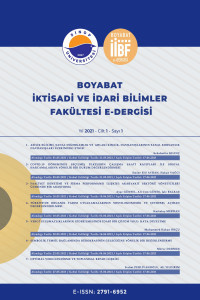Orta Doğu’da Çin’in Diş Politika Faaliyetleri: Enerji Güvenliğini Sağlamak Mı Yoksa Yükselen Bir Güç Olmak Mı?
Orta Doğu'nun stratejik haritası, geleneksel güçlerin bölgesel yönetimden çekilmesi ve bölgedeki genişleyen güç boşluğuyla birlikte yavaş yavaş değişiyor. Son zamanlarda artan ilgi, bölgesel politika ve çatışma yönetimine katılımlarını artırma yetenekleri ve potansiyeli olan Çin gibi yükselen güçlere odaklanıyor. Bununla birlikte, sorun şu ki, son zamanlarda yükselen güçlerden biri ve Orta Doğu ülkelerinin önemli bir ticaret ve enerji ortağı olan Çin, bölgesel düzeni istikrara kavuşturacak bölge dışı bir lider rolünü üstlenmeye istekli ve yetkin mi? Bu makalede, Çin'in Orta Doğu politikasının arkasındaki nedenleri ve Çin'in bölgedeki varlığını artırmasına rağmen, bölgesel siyaseti şekillendirmede henüz büyük bir güç olmaya hazır olmadığı ele alınacaktır.
Anahtar Kelimeler:
Çin, Orta Doğu, Enerji Güvenliği, Kuşak ve Yol İnisiyatifi, Jeoekonomi.
___
- Blackwill, R. D. And Harris, J. M., (2016), War By Other Means:Geoeconomics And Statecraft,The Belknap Press Of Harvard University Press, Cambridge, MA, 2016, s.1.
- Cafiero,G and Wagner,D, (2017), ‘What the Gulf States think of “One Belt, One Road”: Saudi Arabia, UAE, Qatar, and Oman have mixed feelings about China’s ambitious project’, The Diplomat, 24 Mayıs 2017˂https://thediplomat.com/2017/05/what-the-gulf-states-think-of- one-belt-oneroad/˃ (Erişim t: 15 Haziran 2018).
- Calabrese, J, (2017), ‘China’s role in post-hegemonic Middle East’, Real Clear World, 1 Mayıs 2017˂http://www.realclearworld.com/articles/2017/05/01/how_china_and_america_can_sh are_ the_mideast_burden.html˃ (erişim t: 18 Haziran 2018).
- Calabrese, op. cit.; CIA The World Factbook. ‘Imports—Partners’ ˂http://www.cia.gov/ library/publications/resources/the-worldfactbook/fields/2061.html#ag˃ (erişim t: 24 Temmuz2020).
- Daniels, O and Brown, C, (2015), ‘China’s energy security Achilles heel: Middle Eastern oil’, The Diplomat, 8 Eylül 2015 ˂http://www.thediplomat.com/2015/09/chinas-energy-securityachilles-heel-middleeastern-oil˃ (erişim t: 21 Temmuz 2018).
- Dorraj,M, (2016), ‘The future of Sino-Iran relations’, in N. Horesh (ed.), Toward Well-Oiled Relations: Chinaʼs Presence in the Middle East Following the Arab Spring, Palgrave Macmillan,Basingstoke and New York, 2016, ss. 207, 211.
- Erickson, A. S. and Strange, A., (2015), ‘China’s global maritime presence: hard and soft dimensions of PLAN antipiracy operations’, China Brief 15, 2015 ˂https://jamestown.org/pro gram/chinas-global-maritime-presence-hard-and-softdimensions-of-plan-antipiracy- operations˃ (Erişim t: 27 Temmuz 2018).
- Freeman, C. W. Jr., ‘“One Belt, One Road”: what’s in it for us? Remarks to a Workshop of the China Maritime Studies Institute’, Middle East Policy Council ˂http://www.mepc.org/ speeches/onebelt-one-road-whats-it-us˃ (Erişim t: 15 Ocak 2018).
- Fulton, J., E.g., (2017), ‘China is trying to pull Middle East countries into its version of NATO’, The Washington Post, 21 Haziran 2017˂http://www.washingtonpost.com/news/monkey-cage/wp/ 2017/06/21/how china-is-shifting-toward-the-middle-east˃ (erişim t: 20 Temmuz 2018).
- Garver, J, W, (2016), ‘China and Iran: expanding cooperation under conditions of US domination’, in N. Horesh (ed.), Toward Well-Oiled Relations: Chinaʼs Presence in the Middle East Following the Arab Spring, Palgrave Macmillan, Basingstoke and New York, 2016, s. 197.
- Hayoun, M., (2016), ‘China’s approach to the Middle East looks familiar’, The Diplomat, 29 November 2016 ˂http://www.thediplomat.com/2016/11/chinasapproach- to-the-middle-east-looks-familiar˃ (Erişim tarihi: 28 Ekim 2018).
- Horesh, N. and Xu, R., (2016), ‘Conclusion: Chinaʼs growing presence in the Middle East’, in N. Horesh (ed.), Toward Well-Oiled Relations: Chinaʼs Presence in the Middle East Following theArab Spring, Palgrave Macmillan, Basingstoke and New York, 2016, s. 217.
- İstikbal, D. Rejimin Meşrutiyeti ve Enerji Güvenliği: Çin Komünist Partisinin Enerji Politikaları/Legitimacy Of The Regime And Energy Security: Chinese Communist Party’s Energy Policies. Uluslararası Ekonomi İşletme ve Politika Dergisi, 3(1), 49-68.
- Kemp, G, (2010), The East Moves West: India, China, and Asiaʼs Growing Presence in the MiddleEast, Brookings Institution Press, Washington, DC, 2010, ss. 12–13.
- Lehr, D., (2017), ‘The Middle East is the hub for China’s modern Silk Road’, Middle East Institute, 15 Ağustos 2017 ˂http://www.mei.edu/content/map/middle-east-hubchina-s-modern-silk-road˃ ( Erişim t: 15 Kasım 2018).
- Leverett, F and Bader, J, (2006), ‘Managing China‒U.S. energy competition in theMiddle East’, The Washington Quarterly, 29(1), 2006, s. 188.
- Leverett, F and Bader, J, (2006), ‘Managing China‒U.S. energy competition intheMiddle East’, The Washington Quarterly, 29(1), 2006, s. 193.
- Nine Middle Eastern countries are also members of the Asian Infrastructure Investment Bank (AIIB)—a multilateral development bank initiated and established by China in winter 2015/2016.
- Ponížilová, Martina (2019) Foreign Policy Activities Of China İn The Middle East: Establishing Energy Security Or Being A Responsible Emerging Power? Journal Of Balkan And Near Eastern Studies, 21:6, 643-662, DOI:10.1080/19448953.2018.1506292
- Wang, X, (2017), ‘One Belt, One Road’s governance deficit problem: how China can ensure transparency and accountability’, Foreign Affairs, 17 November 2017 ˂https://www.foreign affairs.com/articles/east-asia/2017-11-17/one-belt-one-roadsgovernance-deficit-problem˃ (Erişim t: 15 Haziran 2020).
- Weng, H. Ng., (2017), ‘China, the wild card in the Israel‒Palestine peace process’, Asia Times, 4 Mart 2017 ˂http://www.atimes.com/china-wild-card-israel-palestinepeace-process˃ (Erişim t: 27 Eylül 2018).
- Yılmaz, H., (2016), "Ortadoğu’nun Jeo-Ekonomik Önemi ve Abd’nin Ortadoğu Politikasının Ekonomik Nedenleri." Tesam Akademi 3.1.
- Başlangıç: 2021
- Yayıncı: Sinop Üniversitesi
Sayıdaki Diğer Makaleler
Batı Karadeniz Bölgesinin Örgütsel Ekolojisi: Covıd-19 Pandemisi Süreci Üzerine Bir Değerlendirme
Kamu Yönetiminde Halkla İlişkiler Bağlamında CİMER ve Kamu Denetçiliği Kurumunun Karşılaştırılması
Tuba KARACA BELLİ, Mehmet GÖKKIZ, Şahin BELLİ, Adnan HAKAN, Işıl AKINCI
Okul Liderliği ve Personel Güçlendirme İlişkisi
Whıstleblowıng ve Yönetişim: Paydaş Olan Halkın Aydınlatılmasında Kurum İçerisinden Bir Destek
Cihan Necmi GÜNAL, Maksud Emre MÜLAZIMOĞLU
